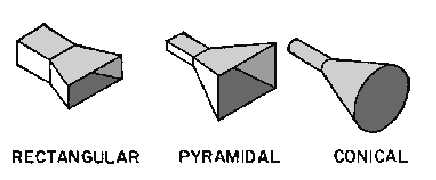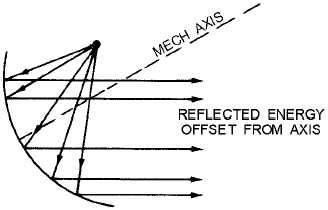3-21
Figure 3-21.—Horn radiators.
FEEDHORNS
A waveguide horn, called a FEEDHORN, may be used to feed energy into a parabolic dish. The
directivity of this feedhorn is added to that of the parabolic dish. The resulting pattern is a very narrow
and concentrated beam. In most radars, the feedhorn is covered with a window of polystyrene fiberglass
to prevent moisture and dirt from entering the open end of the waveguide.
One problem associated with feedhorns is the SHADOW introduced by the feedhorn if it is in the
path of the beam. (The shadow is a dead spot directly in front of the feedhorn.) To solve this problem the
feedhorn can be offset from center. This location change takes the feedhorn out of the path of the rf beam
and eliminates the shadow. An offset feedhorn is shown in figure 3-22.
Figure 3-22.—Offset feedhorn.
AIRBORNE RADAR ANTENNAS
Airborne radar equipment is used for several specific purposes. Some of these are bombing,
navigation, and search. Radar antennas for this equipment are invariably housed inside nonconducting
radomes, not only for protection but also to preserve aerodynamic design. Some of these radomes are
carried outside the fuselage, while others are flush with the skin of the fuselage. In the latter case, the
radar antenna itself is carried inside the fuselage, and a section of the metallic skin is replaced by the
nonconducting radome. The radar antenna and its radome must operate under a wide variety of
temperature, humidity, and pressure conditions. As a result, mechanical construction and design must
minimize any possibility of failure. Transmission lines are usually hermetically sealed to prevent moisture



